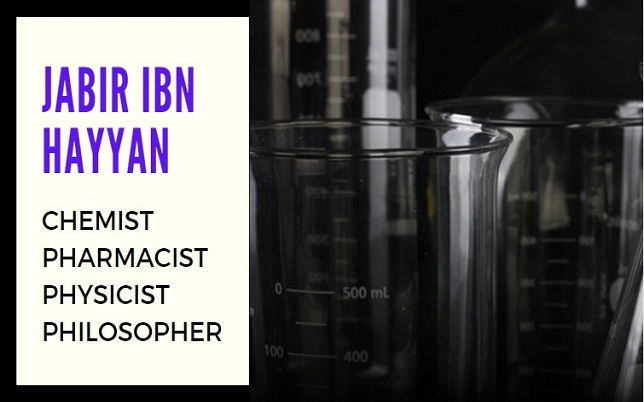Chemistry is one of the sciences to which Muslims have made the greatest contribution. They developed it to such a high degree of perfection that they were considered authority in this specific branch of science. Till the end of the 17th century, Jabir and Zakriya Razi have the distinction of being the greatest chemists that mediaeval times have produced.
Contents
Great Contribution of Arab Muslims in Chemistry
Philip K. Hitti on Arab Sciences
Writing in his illuminating History of the Arabs, Phillip K. Hitti acknowledges the greatness of the Arabs in this branch of science. He says:
“After materia medica, astronomy and mathematics, the Arabs made their greatest scientific contribution to chemistry.
In the study of chemistry and other physical sciences, the Arabs introduced the objective experiment, a decided improvement upon the hazy speculation of the Greeks.
Accurate in observation of phenomena and diligent in the accumulation of facts, the Arabs nevertheless found it difficult to project proper hypotheses.”
Robert Briffault on Muslim Scientists
Another well-known historian, Robert Briffault frankly admits the debt which modern chemistry owed to the Muslim scientists:
“Chemistry, the rudiments of which arose in the process employed by Egyptian metallurgists and jewellers combining metals into various alloys and “tinting” them to resemble gold processes long preserved as a secret monopoly of the priestly colleges and clad in the usual mystic formulas, developed in the hands of the Arabs into a widespread, organised passion for research which led them to the invention of distillation, sublimation infiltration, to the discovery of alcohol, of nitric and sulphuric acids (the only acid known to the ancients was vinegar), of the alkalis, of the salts of mercury, of antimony and bismuth, and laid the basis, of all subsequent chemistry and physical research.”
George Sarton on Jabir Ibn Hayyan
“Jabir would still remain a very impressive personality at once because of his own achievements and because of the glamour traditionally attached to him. The most famous alchemist of Islam, Jabir ibn Hayyan, seems to have good experimental knowledge of a number of chemical facts.”
Life of Jabir Ibn Hayyan
Jabir ibn Hayyan-al-Azdi, called as Sufi (Mystic) known as Geber in the West flourished in Kufa about 776 A.C. and is reputed as the father of modern chemistry. Jabir along with Zakariya Razi, stand as the greatest names in the annals of mediaeval chemical science.
His father was a druggist in Kufa who died a “martyr” to the Shiite propaganda.
Jabir received his education from the Umayyad Prince Khalid ibn Yazid ibn Muawiya and from the celebrated Imam Jafar al-Sadiq.
In the beginning he practised as a physician and was closely attached to the house of Bermakides, whose members occupied the high posts of viziers during the reign of Haroon ar-Rashid. Jabir, too, had to share the misfortune of Bermakides at the time of their downfall in A.C. 803 and died in exile at Kufa. His famous laboratory was found in ruins about two centuries later.
Works of Jabir Ibn Hayyan
Jabir is credited to have composed more than 100 works of which 22 chemical works are still extant. He introduced experimental research in chemical science which immensely added to its rapid development.
The latest research of a few western scholars has confused the issue and has revealed that the chemical works ascribed to Jabir were composed during the 10th century A.C. by a Secret Society similar to the so-called ‘Ikhwan-as-Safa’ (Brethren of Purity) as the Greek references quoted by Jabir had not been translated by the end of the 8th century. But the overwhelming historical evidences found in the Arabic language falsify this contention of the few western scholars who must have based their conclusion on inadequate data.
The fame of Jabir rests on his alchemical writings preserved in Arabic. Five of his works namely Kitab al Rahmah (Book of Mercy), Kitab al Tajmi (Book of Concentration), Al Zilaq al Sharqi (Book of Eastern Mercury), Book of the Kingdom and the little Book of Balances, have been published.
Writes George Sarton:
“We find in them remarkably sound views on method of chemical research, a theory on the geologic formation of metals; the so-called sulphur, mercury theory of metals (the six metals differ essentially because of different proportions of sulphur and arsenic and antimony for their sulphides).
Jabir deals also with various applications of refinement of metals, preparation of steel, dyeing of cloth and leather, varnishes to waterproof cloth and protect iron, use of manganese dioxide in glass making, use of iron pyrites for writing in gold, distillation of vinegar to concentrate acetic acid. He observed the imponderability of magnetic force.”
He worked on the assumption that metals like lead, tin and iron, could be transformed into gold by mixing certain chemical substances. It is said that he manufactured a large quantity of gold with the help of that mysterious substance and two centuries later when a road was laid in Kufa, a large piece of gold was unearthed from his laboratory.
He laid greater emphasis on the importance of experimentation in his researches; hence he made great headway in the chemical science. The Western writers credit him with the discovery of several chemical compounds, which are not to be found in his twenty-two extant Arabic works.
According to Max Meyerhof,
“His influence may be traced throughout the whole historic course of European alchemy and chemistry.”
As already stated above he is the author of more than 100 chemical works.
Says Phillip K. Hitti,
“Nevertheless, the works to which his name was attached, were after the 14th century, the most influential chemical treatises in both Europe and Asia.”
Contributions of Jabir Ibn Hayyan
He explained scientifically the two principal functions of chemistry; calcination and reduction, and registered a marked improvement in the methods of evaporation, sublimation, distillation, melting and crystallization.
Jabir modified and corrected the Aristotelian theory of constituents of the metal, which remained unchanged till the beginning of the modern chemistry in the 18th century A.C.
He has explained in his works the preparation of many chemical substances including “cinnabar” (Sulphide of Mercury) and arsenious oxide.
It has been established through historical researches that he was conversant with the preparation of nearly pure vitriols, alums, alkalis and the production of the so-called liver and milk of sulphur by heating sulphur with alkali.
He prepared mercury oxide and was thoroughly conversant with the preparation of crude sulphuric and nitric acids.
He knew the method of the solution of gold and silver with this acid.
Al-Razi has classified alchemical substances as vegetables, animals or minerals, whereas Jabir and other Arabian chemists have divided mineral substances into bodies (gold, silver, etc.), souls (sulphur, arsenic, etc.) and spirits (mercury and sal-ammoniac).
Jabir is also the author of a book on astrolabe and has written several treatises on spherical trigonometry.
Translations of works of Jabir Ibn Hayyan
His chemical treatises have been translated into several European languages including Latin and had a deep influence over the entire course of the development of modern chemistry.
Several technical scientific terms coined by Jabir found their way in various European languages through Latin and were adopted in modern chemistry. Among these technical words and terms are realigar (red sulphide of arsenic) tutia (Zinc Oxide), alkali, antimony (Arabic Ithimid), alembic for the upper and aludel for the lower part of distillation vessel. Sal ammoniac, a new chemical substance which has been explained in the works of Jabir was unknown to the Greeks. The ammonium referred to in the writings of Greek scientists was in fact a sort of rock salt.
A real estimate of Jabirs achievements is only possible when his enormous chemical works including the Book of Seventy are published.
Richard Russel (1678), an English translator, ascribes a book entitled Sun of Perfection to Jabir. He considers Jabir as the “most famous Arabian prince and philosopher.”
A number of his chemical works have been published by Bertholot, which according to him, are anthropomorphic and animistic.
His works translated into English are Book of Kingdom, Book of Balance and the Book of Eastern Mercury. Latin was the first European language in which the works of Jabir were translated.
In 1144 Englishmen Robert of Chester made the first translation of Jabir’s book on the Composition of Alchemy. His Book of Seventy was translated into Latin by Gerard of Cremona (d /1187 A.C.) the celebrated translator of Arabic Scientific Works.
Extensions of works of Muslim Scientists by Western Scientists
Jabir has been recognized as the Master by the later chemical scientists, including Al Tughrai and Abu Al-Qasim Al-lraqi who nourished during the 12th and 13th centuries A.C. respectively. These Muslim chemists made little improvement on the methods of Jabir. They confined themselves to quest of the legendary “elixir” (Al-lksir) which they could never find out.
During the 12th century hardly any monumental creative scientific work was added to the long list of Arab scientific works. The writers during this period confined themselves to the reproduction, summarization and writing commentaries on the works of Razi (Rhazes) ibn Sina (Avicenna) and Jabir (Geber).
The works of great Muslim scientists including Alhazen, Geber,Avicenna and Rhazes have been expounded by the celebrated English scientist Roger Bacon and his rival Albert of Bollstaedt (Aibertus Magnus). The influence of Alhazen’s ‘Thesaurus opticae’ may be traced to the optics written by Roger Bacon. Similarly, Albert incorporated the alchemical teachings and formulas of Jabir in his De Mineralibus.
An European writer writes in the Encyclopaedia Speculum Naturale by Vicent de Beauvais:
“The influence of Geber is very pronounced, the alchemical tracts ascribed to Arnold of Villanova and to Raymond Lull are full of quotations from Geber. Arabic alchemy, associated as it was with astrology, predominated throughout the 13th and 14th centuries.”

